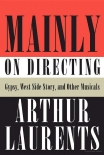Mainly on Directing, Arthur Laurents [best books for students to read TXT] 📗

- Author: Arthur Laurents
Book online «Mainly on Directing, Arthur Laurents [best books for students to read TXT] 📗». Author Arthur Laurents
Jerry and Harvey and I were more than merely on the same go-get-them page. The collaboration was a joy from the first day in Jerry's studio to the last preview in Boston, where the show had its tryout. Each morning after a preview, the three of us would meet for breakfast. They would give me their notes and I would give them mine. Finally, no one had any notes, but Harvey had a request. “I wish they would kiss at the end.”
The two male leads danced off into the sunset at the end as I staged it. “Kiss where?”
On the lips would risk losing the audience we had worked so carefully to get, and Harvey knew that. “On the cheeks,” he said.
“French men kiss on both cheeks regularly,” I said.
“I hate it when they just touch,” Jerry said, and we called for the check.
• • •
The first question when starting work on a show is: what is it about? The answer tells where to put the focus. Both play and movie focused on camp elements in the relationship between the two men. What effectively counterbalanced camp in the movie was the presence of the boy's natural mother. A very French woman, or at least what Lampshade Harry and his squealing wife would think a very French woman was: chic and sexy and a threat. A figure that could add a color to the musical, vary the tone, broaden the range, and shift the focus of the story to the boy and his mother. Except that ours couldn't. Unless we wanted to be sued, the woman couldn't appear in the musical, because she didn't appear in the play. Paradoxically, that limitation led me to what the musical could be about. The story was thin, even for a musical; moreover, it was neither inherently funny nor dramatic. What was needed was something to grab the audience and give it someone or something to root for. La Cage aux Folles the musical was going to be about a boy who comes to accept a man as his mother. There we were! The focus on family and off sex. And the story had an unexpected heart. Even a little heart would be a big help in a tale of two queens. Especially in a multimillion-dollar musical tale of two queens, one a drag queen, the other his lover.
That mother/son approach conceivably could be tracked to material buried in both the play and the film, but a literal adaptation wasn't desirable anyway. Literal adaptations start a musical off in trouble. No form is comfortable in another form, and the addition of music brings a change that demands change in attitudes. The adapters must be clear why they're attempting this work. What's their purpose? What's their viewpoint? To achieve the purpose, material from the original will be kept or discarded or embellished, and always as seen from a special viewpoint.
• • •
We took what we could from the Jean Poiret play and began cobbling a show. I structured; Harvey wrote scenes in a loose-leaf notebook; Jerry wrote songs on his melodic baby grand. Work was interrupted two or three times a week to raise money via auditions held in Jerry's top-floor studio for investors perched everywhere, even on the little balcony and under the trapeze. Allan was good at rounding up money. My concentration was on testing the story as we developed it and inventing what we hadn't gotten to. There are worse ways of writing a musical, judging from the current crop. Occasionally we could see which was the way to go. The emphasis on the boy accepting a man as his mother got a tangible response: checks! A new song Jerry sold at his piano: checks! (Jerry Herman could have had a big career just singing and playing to raise money.) But the Fritz Holt—like enthusiasm we were hoping for remained elusive; the checks weren't that many or that big … until one audition day an idea popped out without warning. I had reached the section of my pitch explaining the show's chorus of drag queens (named Les Cagelles, because it sounded French) when I heard myself say:
“Two of them are actually girls, the rest are boys. The audience will be trying to find out which is which, but they won't know until the curtain call.”
Not a bad idea, I thought, not at all—in fact, pretty good. Very good, thought the putative investors—terrific, in fact. They applauded—big-time, as Allan put it. They ceased being putative: the big-money ball began rolling in. That I didn't have a clue how Which-Cagelle-is-what? was going to be worked out didn't matter to Allan. It had to be worked out; therefore, it would be worked out—and he was right: it would be and it was. What I didn't and couldn't foresee was that thanks to word of mouth and a good press agent, Shirley Herz, Which-is-what? would become one of the best sellers of the show. It had nothing to do with the story; it was just smoke and mirrors—the theatrical magic this musical Cage aux Folles needed.
Smoke and mirrors have always played an important role in musicals, most obviously through the scenery: the merry-go-round in The Band Wagon, the chandelier in Phantom, the helicopter in Miss Saigon, the projections in Tommy, the hanging starlight bulbs by Kevin Adams for Spring Awakening. Sometimes the smoke makes the audience cough and the mirrors are cracked—or, worse,





Comments (0)